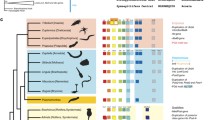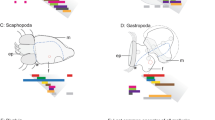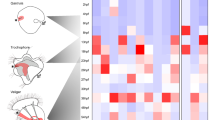Abstract
The pycnogonids (or sea spiders) are an enigmatic group of arthropods, classified in recent phylogenies as a sister-group of either euchelicerates (horseshoe crabs and arachnids), or all other extant arthropods. Because of their bizarre morpho-anatomy, homologies with other arthropod taxa have been difficult to assess. We review the main morphology-based hypotheses of correspondence between anterior segments of pycnogonids, arachnids and mandibulates. In an attempt to provide new relevant data to these controversial issues, we performed a PCR survey of Hox genes in two pycnogonid species, Endeis spinosa and Nymphon gracile, from which we could recover nine and six Hox genes, respectively. Phylogenetic analyses allowed to identify their orthology relationships. The Deformed gene from E. spinosa and the abdominal-A gene from N. gracile exhibit unusual sequence divergence in their homeodomains, which, in the latter case, may be correlated with the extreme reduction of the posterior region in pycnogonids. Expression patterns of two Hox genes (labial and Deformed) in the E. spinosa protonymphon larva are discussed. The anterior boundaries of their expression domains favour homology between sea spider chelifores, euchelicerates chelicerae and mandibulate (first) antennae, in contradistinction with previously proposed alternative schemes such as the protocerebral identity of sea spider chelifores or the absence of a deutocerebrum in chelicerates. In addition, while anatomical and embryological evidences suggest the possibility that the ovigers of sea spiders could be a duplicated pair of pedipalps, the Hox data support them as modified anterior walking legs, consistent with the classical views.



Similar content being viewed by others
References
Abzhanov A, Kaufman T (1999) Homeotic genes and the arthropod head: expression patterns of the labial, proboscipedia, and Deformed genes in crustaceans and insects. Proc Natl Acad Sci USA 96:10224–10229
Abzhanov A, Popadic A, Kaufman TC (1999) Chelicerate Hox genes and the homology of arthropod segments. Evol Dev 1:77–89
Arango CP (2003) Molecular approach to the phylogenetics of sea spiders (Arthropoda: Pycnogonida) using partial sequences of nuclear ribosomal DNA. Mol Phylogenet Evol 28:588–600
Averof M (1998) Origin of the spider’s head. Nature 395:436–437
Babu KS (1965) Anatomy of the central nervous system of arachnids. Zool Jb Anat 82:1–154
Bain BA (2003a) Larval types and a summary of postembryonic development within the pycnogonids. Invertebr Reprod Dev 43:193–222
Bain BA (2003b) Postembryonic development in the pycnogonid Austropallene cornigera (Family Callipallenidae). Invertebr Reprod Dev 43:181–192
Behrens W (1984) Larvenentwicklung und Metamorphose von Pycnogonum litorale (Chelicerata, Pantopoda). Zoomorphology 104:266–279
Borradaile LA, Potts FA, Eastham LES, Saunders JT, Kerkut, GA (1961) The invertebrata: a manual for the use of students, 4th edn. Cambridge University Press, London
Boyan G, Reichert H, Hirth F (2003) Commissure formation in the embryonic insect brain. Arthropod Struct Dev 32:61–77
Brauer A (1894) Beiträge zur Kenntnis der Entwicklungsgeschichte des Skorpions I. Z Wiss Zool 57:402–432
Brusca RC, Brusca GJ (2003) Invertebrates, 2nd edn. Sinauer, Sunderland, Massachusetts
Budd GE (2002) A palaeontological solution to the arthropod head problem. Nature 417:271–275
Budd GE, Telford MJ (2005) Along came a sea spider. Nature 437:1099–1102
Bullock TH, Horridge GA (1965) Structure and function in the nervous systems of invertebrates, vol II. Freeman, San Francisco and London
Burke AC, Nelson CE, Morgan BA, Tabin C (1995) Hox genes and the evolution of vertebrate axial morphology. Development 121:333–346
Carroll SB (2005) The new science of Evo Devo: endless forms most beautiful. Norton and Co, New York, London
Carroll SB, Grenier J, Weatherbee SD (2005) From DNA to diversity: molecular genetics and the evolution of animal design, 2nd edn. Blackwell, London
Chen J, Waloszek D, Maas A (2004) A new “great-appendage” arthropod from the lower Cambrian of China and homology of chelicerate chelicerae and raptorial antero-ventral appendages. Lethaia 37:3–20
Colgan DJ, McLauchlan A, Wilson GDF, Livingston S, Edgecombe GD, Macaranas J, Cassis G, Gray MR (1998) Histone H3 and U2 snRNA sequences and arthropod molecular evolution. Aust J Zool 46:419–437
Coyne JA (2005) Switching on evolution. Nature 435:1029–1030
Damen WGM, Hausdorf M, Seyfarth E-A, Tautz D (1998) A conserved mode of head segmentation in arthropods revealed by the expression pattern of Hox genes in a spider. Proc Natl Acad Sci USA 95:10665–10670
Deutsch JS, Mouchel-Vielh E (2003) Hox genes and the crustacean body plan. BioEssays 25:878–887
Doyle JJ, Doyle JL (1987) A rapid DNA isolation procedure for small quantities of fresh leaf tissue. Phytochem Bull 19:11–15
Duboule D (1994) Guide book to the homeobox genes. Oxford University Press, Oxford
Dunlop JA, Arango CP (2004) Pycnogonid affinities: a review. J Zool Syst Evol Res 43:8–21
Edgecombe G, Wilson GDF, Colgan DJ, Gray MR, Cassis G (2000) Arthropod cladistics: combined analysis of histone H3 and U2 snRNA sequences and morphology. Cladistics 16:155–203
Eriksson BJ, Tait NN, Budd GE (2003) Head development in the onychophoran Euperipatoides kanangrensis with particular reference to the central nervous system. J Morphol 255:1–23
Frohman MA, Dush MK, Martin GR (1988) Rapid production of full-length cDNAs from rare transcripts: amplification using single gene-specific oligonucleotide primer. Proc Natl Acad Sci USA 85:8998–9002
Gilbert SF (2003) Developmental biology, 7th edn. Sinauer, Sunderland, Massachusetts
Giribet G, Edgecombe GD, Wheeler WC (2001) Arthropod phylogeny based on eight molecular loci and morphology. Nature 413:157–161
Giribet G, Edgecombe GD, Wheeler WC, Babbitt C (2002) Phylogeny and systematic position of Opiliones: a combined analysis of chelicerate relationships using morphological and molecular data. Cladistics 18:5–70
Guindon S, Gascuel, O (2003) A simple fast and accurate algorithm to estimate large phylogenies by Maximum Likelihood. Syst Biol 52:696–704
Hassanin A (2006) Phylogeny of arthropoda inferred from mitochondrial sequences: strategies for limiting the misleading effects of multiple changes in pattern rates of substitution. Mol Phylogenet Evol 38:100–116
Hassanin A, Léger N, Deutsch J (2005) Evidence for multiple reversals of asymmetric mutational constraints during the evolution of the mitochondrial genome of Metazoa, and consequences for phylogenetic inferences. Syst Biol 54:277–298
Hughes CL, Kaufman TC (2002a) Hox genes and the evolution of the arthropod body plan. Evol Dev 4:459–499
Hughes CL, Kaufman TC (2002b) Exploring the myriapod body plan: expression patterns of the ten Hox genes in a centipede. Development 129:1225–1238
Jager M, Hassanin A, Manuel M, Le Guyader H, Deutsch J (2003) MADS-box genes in Ginkgo biloba and the evolution of the AGAMOUS family. Mol Biol Evol 20:842–854
Jager M, Murienne J, Clabaut C, Deutsch J, Le Guyader H, Manuel, M (2006) Homology of arthropod anterior appendages revealed by Hox gene expression in a sea spider. Nature 441(7092):506–508
Jarvis JH, King PE (1978) Reproductive biology of British pycnogonids (oögenesis and the reproductive cycle). Zool J Linn Soc 63:105–131
Jones DT, Taylor WR, Thornton JM (1992) The rapid generation of mutation data matrices from protein sequences. CABIOS 8:275–282
Leach WE (1814) The zoological miscellany, vol. 1, pp 33–34, 43–45
Mallatt JM, Garey JR, Shultz JW (2004) Ecdysozoan phylogeny and bayesian inference: first use of nearly complete 28S and 18S rRNA gene sequences to classify the arthropods and their kin. Mol Phylogenet Evol 31:178–191
Maxmen A, Browne WE, Martindale MQ, Giribet G (2005) Neuroanatomy of sea spiders implies an appendicular origin of the protocerebral segment. Nature 437:1144–1148
Meisenheimer J (1902) Beiträge zur Entwicklungsgeschichte der Pantopoden. I. Die Entwicklung von Ammothea echinata Hodge bis zur Ausbildung der Larvenform. Z wiss Zool 72:191–248
Mittmann B, Scholtz G (2003) Development of the nervous system in the “head” of Limulus polyphemus (Chelicerata: Xiphosura): morphological evidence for a correspondence between the segments of the chelicerae and of the (first) antennae of Mandibulata. Dev Genes Evol 213:9–17
Montagu G (1808) Description of several marine animals found on the South Coast of Devonshire. Trans Linn Soc London 9:81–113
Mouchel-Vielh E, Rigolot C, Gibert JM, Deutsch JS (1998) Molecules and the body plan: the Hox genes of cirripedes (Crustacea). Mol Phylogenet Evol 9:382–389
Mouchel-Vielh E, Blin M, Rigolot C, Deutsch JS (2002) Expression of a homologue of the fushi tarazu (ftz) gene in a cirripede crustacean. Evol Dev 4:76–85
Murtha M, Leckman JF, Ruddle FH (1991) Detection of homeobox genes in development and evolution. Proc Natl Acad Sci USA 88:10711–10715
Page DT (2004) A mode of arthropod brain evolution suggested by Drosophila commissure development. Evol Dev 6:25–31
Pavlopoulos A, Averof M (2002) Developmental evolution: Hox proteins ring the changes. Curr Biol 12:R291–R293
Pearse V, Pearse J, Buchsbaum M, Buchsbaum R (1987) Living invertebrates. Blackwell/Boxwood, Pacific Grove, California
Popadic A, Panganiban G, Rusch D, Shear WA, Kaufman TC (1998) Molecular evidence for the gnathobasic derivation of arthropod mandibles and for the appendicular origin of the labrum and other structures. Dev Genes Evol 208:142–150
Quéinnec E (2001) Insights into arthropod head evolution. Two heads in one: the end of the “endless dispute”? Ann Soc Entomol Fr 37:51–69
Regier JC, Shultz J (2001) Elongation factor-2: a useful gene for arthropod phylogenetics. Mol Phylogenet Evol 20:136–148
Ronshaugen M, McGinnis N, McGinnis W (2002) Hox protein mutation and macroevolution of the insect body plan. Nature 415:914–917
Sanchez S (1959) Le développement des pycnogonides et leurs affinités avec les arachnides. Thèses CNRS, Paris
Sandeman DC, Scholtz G, Sandeman R (1993) Brain evolution in decapod crustacea. J Exp Zool 295:112–133
Scholtz G, Edgecombe GD (2005) Heads, Hox and the phylogenetic position of trilobites. Crustac Issues 16:139–165
Shultz JW, Regier JC (2000) Phylogenetic analysis of two nuclear protein-encoding genes in arthropods supports a crustacean-hexapod clade. Proc R Soc Lond B 267:1011–1019
Simonnet F, Deutsch J, Quéinnec E (2004) hedgehog is a segment polarity gene in a crustacean and a chelicerate. Dev Genes Evol 214:537–545
Telford MJ, Thomas RH (1998) Expression of homeobox genes shows chelicerate arthropods retain their deutocerebral segment. Proc Natl Acad Sci USA 95:10671–10675
Vilpoux K, Waloszek D (2003) Larval development and morphogenesis of the sea spider Pycnogonum litorale (Ström, 1762) and the tagmosis of the body of Pantopoda. Arthropod Struct Dev 32:349–383
Waloszek D, Dunlop JA (2002) A larval sea spider (Arthropoda: Pycnogonida) from the Upper Cambrian ‘orsten’ of Sweden and the phylogenetic position of pycnogonids. Palaeontology 45:421–446
Waloszek D, Chen J, Maas A, Wang X (2005) Early Cambrian arthropods—new insights into arthropod head and structural evolution. Arthropod Struct Dev 34:189–205
Weygoldt P (1985) Ontogeny of the arachnid central nervous system. In: Barth FG (ed) Neurobiology of arachnids. Springer, Berlin Heidelberg New York, pp 20–37
Winter G (1980) Beiträge zur Morphologie und Embryologie des vorderen Körperabschnitts (Cephalosoma) der Pantopoda Gerstaecker, 1863. Z Zoolog Syst Evol Forsch 18:27–61
Zrzavy J, Hypsa V, Vlaskova M (1998) Arthropod phylogeny: taxonomic congruence, total evidence and conditional combination approaches to morphological and molecular data sets. In: Fortey RA, Thomas RH (eds) Arthropod relationships. Chapman & Hall, London, pp 97–107
Acknowledgements
We thank the Station Biologique de Roscoff for providing lab facilities for specimen collection and preparation. We are grateful to Jean Deutsch, Eric Quéinnec and Nicolas Rabet for advice and discussion, to Pierrette Lamarre for technical help, and to Thierry Jafredo for lab facilities. This work was founded by CNRS and the French Ministry of Research.
Author information
Authors and Affiliations
Corresponding author
Additional information
Guest editors Jean Deutsch and Gerhard Scholtz
Electronic supplementary material
Below is the link to the electronic supplementary material.
Fig. S1
Colossendeis bicincta, picture showing the proximal part of the proboscis and the anterior region of the cephalosoma, with the insertion of pedipalps (pd) and ovigers (ov) on a common basis (JPEG 183 kb)
Fig. S2
The position of Endeis and Nymphon in the pycnogonid tree derived from the combined analysis of 18S and 28S rDNA and morphological data (Arango 2003). The two species investigated in the present study, Endeis spinosa (male individual) and Nymphon gracile, are illustrated on the right side of the tree. cho chelifore, ov oviger, pd pedipalp (JPEG 284 kb)
Fig S3
Amino-acid sequence alignment of pycnogonid Hox genes with representative genes from several panarthropods and other bilaterians, classified by groups of orthology. The alignment comprises, from left to right, eight positions of the hexapeptide region, six positions in the N-terminal region flanking the homeodomain, the 60 aa of the homeodomain, and ten positions in the C-terminal region flanking the homeodomain. Dashes indicate gaps inserted to align the sequences; blanks correspond to missing data. Black shading indicates amino-acid identity; grey shading indicate amino-acid similarity (for both, the threshold for shading was 40% of the sequences). In the homeodomain, helix 1 spans from position 10 to position 22, helix 2 from 28 to 37 and helix 3 from 42 to 58. Abbreviations of taxon names as in Fig. 3 (DOC 84 kb)
Fig. S4
Maximum Likelihood analysis of the 60-aa (homeodomain) Hox gene dataset. Genes from Endeis spinosa are labelled in red; genes from Nymphon gracile are labelled in blue. ML bootstraps (300 replicates) are indicated above the branches. The scale bar indicates the number of nucleotide substitutions per position in the sequences. LogL=−2262.20753, gamma shape=0.457, proportion of invariant sites=0.041 (JPEG 464 kb)
Table S1
Supplement table (DOC 18 kb)
Rights and permissions
About this article
Cite this article
Manuel, M., Jager, M., Murienne, J. et al. Hox genes in sea spiders (Pycnogonida) and the homology of arthropod head segments. Dev Genes Evol 216, 481–491 (2006). https://doi.org/10.1007/s00427-006-0095-2
Received:
Accepted:
Published:
Issue Date:
DOI: https://doi.org/10.1007/s00427-006-0095-2




